In a world full of musical diversity, World Steel Drum Day emerges as a unique celebration that pays tribute to a fascinating and unconventional instrument. These drums, also known as steel drums or pan drums, have a rich history and vibrant presence in various cultures around the world.
History of Metal Drums
Steel drums have their roots in the Caribbean island of Trinidad and Tobago, where they emerged in the mid-20th century. The story goes that African slaves, after the abolition of slavery, began recycling barrels of oil discarded by the local oil industry to create musical instruments. This ingenious act of repurposing led to the birth of steel drums, a unique form of musical expression that quickly gained popularity in the region.
The first generation of steel drums were made mainly from oil barrels, transformed by hand by local musicians. Over time, this art evolved and was refined, giving way to more complex and fine-tuned steel drums. As the popularity of these instruments grew, they spread throughout the Caribbean and beyond, becoming an integral part of many cultural celebrations.
The Cultural Impact of Metal Drums
The arrival of steel drums not only marked a milestone in the evolution of music, but also had a profound impact on the cultural identity of the communities that adopted this instrument. These drums became symbols of resistance, creativity, and the human ability to transform everyday objects into meaningful art forms.
In Trinidad and Tobago, steel drums are central to festivals such as Carnival, where steel drum bands compete in competitions to display their musical prowess and ability. Additionally, these instruments have found their way into musical genres as diverse as reggae, jazz, and classical music, fusing local traditions with global influences.
Metal Drum Making: An Art in Itself
Steel drum making is truly an art in itself, a unique fusion of craft skills and musical knowledge that brings to life one of the most distinctive and captivating instruments in the world. This meticulous process not only involves the physical creation of the drum, but also requires a deep understanding of music theory and tuning.
Artisans, known as steel drum tuners, play a crucial role in this creative process. Each drum is forged with meticulous attention, starting with recycling discarded oil barrels. These barrels serve as a musical canvas, and tuners, with skills that have been honed over time, transform them into precisely tuned instruments.
The manufacturing process often involves heating and hammering the drum sections to adjust their tuning. Each section of the drum produces a specific note, and the tuner, with a trained ear, ensures that each one is in harmony with the others. This act of craftsmanship goes beyond simply creating an instrument; is the creation of a musical masterpiece that will resonate with sonic richness.
The skill of steel drum tuners is based on experience and intuition, as they painstakingly adjust each section to achieve the perfect balance. Musical sensitivity is combined with physical skill, creating a process in which art and science converge harmoniously. Each drum becomes a unique expression of the craftsman's creativity and mastery.
But the making of steel drums is not just an individual act; is a community effort involving those who share a passion for preserving this art form. The local communities that have kept the steel drum tradition alive play a vital role in its manufacture. The transmission of skills from generation to generation ensures the continuity of this artisanal practice, linking the past with the present and the future.
This art in metal drum manufacturing goes beyond the mere production of instruments; it is a tangible connection to history and culture. Each blow of the hammer and each careful adjustment not only shapes the sound of the drum, but also keeps alive a tradition rooted in human creativity and the ability to transform the ordinary into the extraordinary.
Celebrating World Steel Drum Day
World Steel Drum Day, celebrated on November 10 each year, is an opportunity to highlight the cultural importance of this instrument and honor the musicians and artisans who keep it alive. During this day, communities around the world host events, concerts and workshops to celebrate and share the beauty of steel drums.
In Trinidad and Tobago, the country of origin of steel drums, celebrations are particularly vibrant. Parades, competitions and concerts fill the streets, giving locals and visitors the opportunity to immerse themselves in the rich tradition of this instrument. Additionally, educational workshops are held to teach new generations about the history and manufacturing of steel drums, ensuring that this art form endures over time.
The Globalization of Metal Drums
As steel drums gain popularity around the world, there have been interesting fusions with other musical genres. Musicians from various cultures have incorporated these drums into their compositions, creating works that fuse the traditional with the contemporary.
The globalization of steel drums has also led to the formation of international bands and participation in global music festivals. This has allowed this Caribbean instrument to transcend geographical and cultural borders, connecting people from different parts of the world through music.
The Challenge of Preserving Tradition
Despite their growing popularity, steel drums face challenges to their preservation. Globalization and commercialization can lead to simplified or stereotyped interpretations of this instrument, distancing it from its cultural roots. Additionally, the pressure of industrialization and the limited availability of recycled oil barrels raise concerns about the sustainability of traditional metal drum manufacturing.
To address these challenges, it is crucial to foster respect for cultural authenticity and support local communities involved in steel drum manufacturing. Education about the history and cultural significance of these instruments also plays a vital role in ensuring that future generations continue to appreciate and preserve this unique art form.
Music, through instruments such as steel drums, continues to be a bridge that unites people from diverse cultures, reminding us of the beauty and harmony that we can find in diversity.
